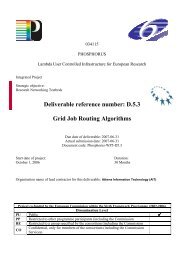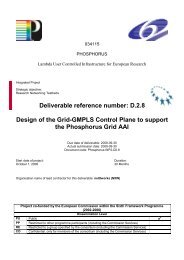D5.9: Extended Simulation Environment - Phosphorus
D5.9: Extended Simulation Environment - Phosphorus
D5.9: Extended Simulation Environment - Phosphorus
You also want an ePaper? Increase the reach of your titles
YUMPU automatically turns print PDFs into web optimized ePapers that Google loves.
D5.6 - <strong>Extended</strong> <strong>Simulation</strong> <strong>Environment</strong><br />
5 NeDeTo (Network Design Tool)<br />
Deploying lambda Grids in a cost-efficient and yet effective manner entails among others prior careful planning<br />
of the target optical network infrastructure. The latter is realized through the application of known optimization<br />
methods to the network design/dimensioning problem, with the ultimate goal of deriving a minimum cost<br />
network that satisfies a set of desired constraints, taking into account the physical layer characteristics<br />
(impairments).<br />
Towards optimizing the design of the <strong>Phosphorus</strong> optical network infrastructure, we have implemented the<br />
Network Design Tool (abbreviated to NeDeTo). Although it is implemented using the MATLAB programming<br />
framework, the tool can be run in the form of a standalone executable in any commodity operating system<br />
(OS), given that a related compiler compatible with the MATLAB framework is used to compile the code with a<br />
specific OS as target. Currently, we have provided for an executable targeted at machines running Microsoft<br />
Windows. In addition, a working MATLAB installation is needed to create .mat input parameter files, as well as<br />
to process the files containing the optimization output results. NeDeTo can be efficiently run on any<br />
contemporary commodity workstation, without stringent or exotic hardware requirements in terms of CPU<br />
frequency, processor architecture, main memory size or hard disk space. Still, the optimization core will greatly<br />
benefit from high-end CPU and memory capabilities, resulting in execution speedup. This is reasonable when<br />
designing medium- to large-scale networks, mainly due to faster processing of the branch-and-bound tree and<br />
due to lower I/O activity between main memory and hard disk for fetching parts of the tree to the working<br />
memory.<br />
5.1 Application Workflow<br />
NeDeTo implements the network design/dimensioning approach presented in [2]. As such, it employs the<br />
respective network cost model and implements the physical impairments model and the specific dimensioning<br />
methods specified in [2].<br />
Figure 5 illustrates the workflow of the design process as perceived by the application user, which follows<br />
naturally from the theoretical specification of the network design approach presented in [2]. The user has first to<br />
specify all information that forms the input to the network design problem that is to be solved by NeDeto. More<br />
precisely, following input is required:<br />
Project:<br />
<strong>Phosphorus</strong><br />
Deliverable Number: <br />
Date of Issue: 2009-03-31<br />
EC Contract No.: 034115<br />
Document Code: <br />
24






